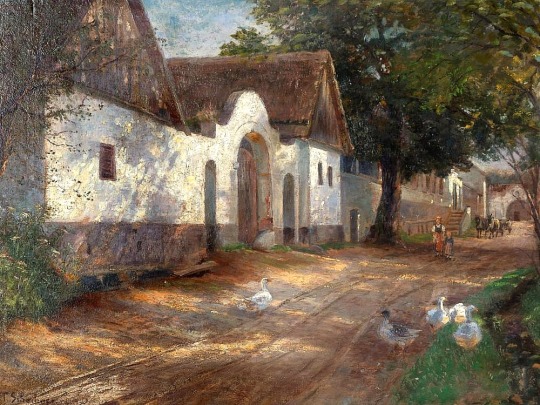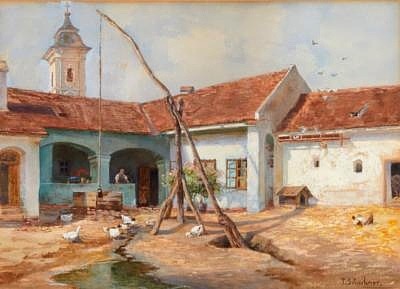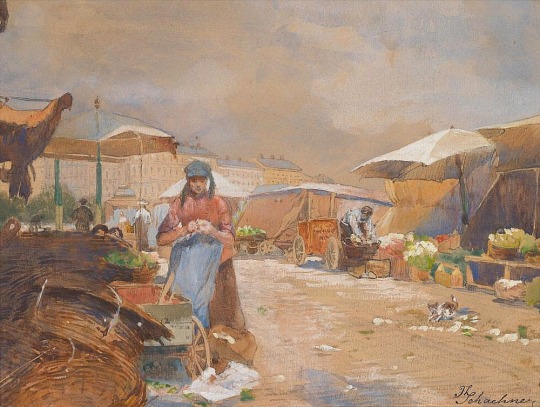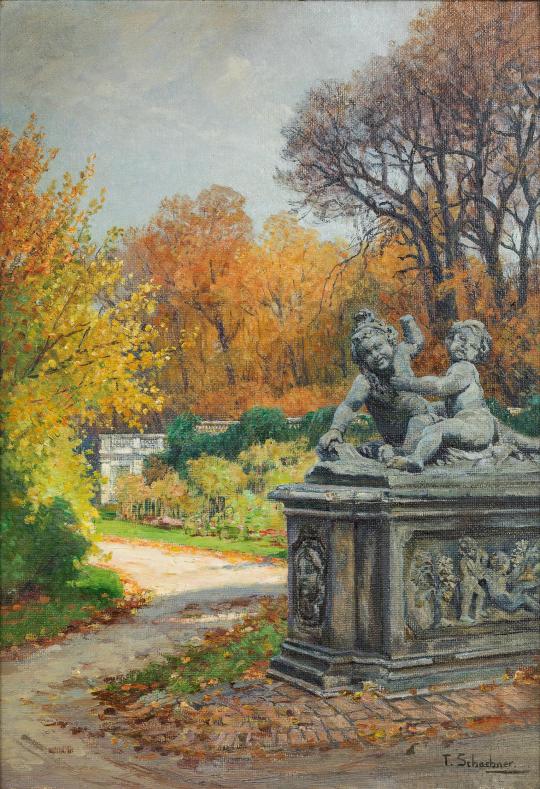#Therese Schachner
Explore tagged Tumblr posts
Text

Therese Schachner (Austrian, 1869 - 1950): Late autumn, Scene from Hadersdorf (via Dorotheum)
#Therese Schachner#women artists#women painters#art#painting#nineteenth century#twentieth century#landscape#austrian painters#for future reference
201 notes
·
View notes
Text
Therese Schachner (1869-1950) pintora austriaca.

Schachner nació en Viena, era una de las hijas del arquitecto Friedrich Schachner, que trabajaba en Viena, y de su esposa, llamada Therese Schachner y cuyo padre era el constructor de catedrales Leopold Ernst. Entre los hijos de la pareja también se encontraba Margarete Schachner, consejera de gobierno y una de las primeras inspectoras escolares de distrito de Viena. Las hijas que tocaban el violín y el piano, Steffi, Irmengild y Fritzi, se hicieron famosas en el ambiente artístico vienés como las “hermanas Schachner”.

Therese Schachner también aparecía en eventos sociales como cantante o música, pero era conocida principalmente por su trabajo como pintora.

Recibió su formación artística principalmente del paisajista Hugo Darnaut . Después de la muerte de Emil Jakob Schindler, alquiló el castillo de Plankenberg de 1893 a 1912 , donde también invitó a sus alumnos. En esta zona se crearon varios de sus paisajes. Entre sus profesores también se encontraban Albin Egger-Lienz, así como Adolf Hölzel y Ludwig Dill. Con este último asistió a cursos en Dachau de 1905 a 1907.

Pintó paisajes y piezas florales, predominantemente al óleo. Fue miembro de la Asociación de Artistas de Austria y de la Asociación de Artistas Visuales de Austria, en cuya junta directiva fue elegida en 1903. Desde 1911 fue miembro correspondiente del club de acuarelistas de la Asociación de Bellas Artes de Viena. Desde principios de siglo hasta la década de 1930 expuso regularmente sus obras, a menudo varias veces al año. En particular, apoyó las exposiciones colectivas de las asociaciones antes mencionadas, como las exposiciones anuales y de acuarelas de la cooperativa en la Künstlerhaus de Viena.

Sus cuadros también se pudieron ver en la Primera Exposición Internacional de Caza en Viena en 1910 y en la exposición de artistas germano-austriacos en la Sala de Exposiciones de Arte de Núremberg en 1915. Por su contribución a la 25ª exposición anual en la Künstlerhaus de Salzburgo, el óleo " Granja bávara" , recibió la medalla estatal de plata en 1909.

Más tarde, también particip�� activamente en la asociación de artistas visuales “Wiener Heimatkunst”, donde se reunían miembros de diversas asociaciones de artistas que tenían una comprensión más conservadora del arte y querían continuarlo en la tradición de sus antepasados.
Presentó la primera exposición anual de “Arte local de Viena” en 1915, y su participación en la exposición en la Palmenhaus se remonta a 1938. En 1931 fue elegida miembro del consejo asesor del comité de la asociación “Arte local de Viena”.

En 1945, Schachner perdió gran parte de sus propiedades y su estudio debido a un bombardeo, pero continuó trabajando como artista.

En 2014, tuvo lugar en la región de museos de Neulengbach la exposición acompañada de un catálogo Colores del paraíso: los jardines paisajísticos de Plankenberger Malerkreis , centrada en la obra de Therese Schachner.

Murió en Viena a la edad de 80 años.
Su obra se encuentra en la colección de la Galería Belvedere.

0 notes
Photo

In the Evening Sun - Therese Schachner , before 1917.
Austrian, 1869 - 1950
oil on cardboard , 53 x 49 cm.
363 notes
·
View notes
Quote
Tra tutte le ipotesi però quella che si è affermata maggiormente è che Nohl potesse semplicemente aver trascritto il titolo in modo errato e che la donna a cui Beethoven aveva dedicato “Per Elisa” fosse in realtà Therese Malfatti, musicista austriaca, studente di Beethoven e una delle varie donne di cui il compositore si invaghì senza essere corrisposto. Secondo questa teoria, ripresa anche da Lebrecht, Beethoven scrisse il brano come dimostrazione di affetto per Therese Malfatti, che lusingata dall’attenzione del compositore lo suonò in varie occasioni. Quando morì, nel 1851, Malfatti lo lasciò in eredità insieme a tutta la sua musica a un pianista con cui aveva suonato: Rudolf Schachner. Su come “Für Therese” fosse diventato “Für Elise” però non erano mai state elaborate vere e proprie teorie ed è qui che il libro di Lebrecht si fa interessante. Schachner infatti era il figlio illegittimo di Babette Bredl, un’ex insegnante di Monaco. Poco dopo la morte di Therese Malfatti decise di trasferirsi a Londra con la famiglia e lasciò a casa della madre i manoscritti ereditati dall’amica, compresa la partitura di Beethoven. La moglie di Schachner si chiamava Elizabeth ma veniva chiamata Elise, e anche la figlia dei due si chiamava Elise. Secondo Lebrecht è possibile che quando Nohl andò a trovare Babette Bredl e trascrisse il brano per intero, copiandolo dall’originale, lei fosse talmente disperata alla notizia della partenza del figlio – e della nipote – che come titolo del manoscritto lesse “Für Elise” anziché “Für Therese”. «Potrebbe essere stato un lapsus dovuto al fatto che stava pensando a sua nipote» ha scritto Lebrecht «o potrebbe averlo fatto deliberatamente, per assicurarsi che la sua piccola Elise a Londra potesse godere di questo frammento di posterità».
Dall’articolo Chi era Elisa di “Per Elisa”? su IlPost.it
2 notes
·
View notes
Text

"In the Evening Sun. 1917". Therese Schachner. Austrian. 1869-1950.
> Huariqueje.Tumblr
0 notes
Video
vimeo
Für Elise - Beethoven | For Elise | Pro Elišku | Bagatelle No. 25 | PianoKos from PianoKos.com on Vimeo.
Bagatelle No. 25 in A minor (WoO 59, Bia 515, and OEIS A123456) for solo piano, commonly known as "Für Elise" or "Fuer Elise" (German: [fyːɐ̯ ʔeˈliːzə] ( listen), English: "For Elise", sometimes written without the German umlaut mark as "Fur Elise"), is one of Ludwig van Beethoven's most popular compositions. It is usually classified as a bagatelle, but it is also sometimes referred to as an Albumblatt.
The score was not published until 1867, 40 years after the composer's death in 1827. The discoverer of the piece, Ludwig Nohl, affirmed that the original autographed manuscript, now lost, was dated 27 April 1810.
The version of "Für Elise" heard today is an earlier version that was transcribed by Ludwig Nohl. There is a later version, with drastic changes to the accompaniment which was transcribed from a later manuscript by the Beethoven scholar Barry Cooper. The most notable difference is in the first theme, the left-hand arpeggios are delayed by a 16th note beat. There are a few extra bars in the transitional section into the B section; and finally, the rising A minor arpeggio figure is moved later into the piece. The tempo marking Poco moto is believed to have been on the manuscript that Ludwig Nohl transcribed (now lost). The later version includes the marking Molto grazioso. It is believed that Beethoven intended to add the piece to a cycle of bagatelles.
If you like my music, please SUBSCRIBE, LIKE or comment this video.
----------------------------------------------------------------------------------------------------------- [CZ] Pro Elišku (německy Für Elise) je krátká hudební skladba pro klavír, kterou v roce 1810 složil Ludwig van Beethoven. Její partituru nalezl teprve v roce 1865 německý vědec Ludwig Nohl.
Pokud se vám moje tvorba líbí, budu rád, když se přihlásíte k odběru tohoto kanálu, udělíte "palec nahoru" či se vyjádříte v komentářích. Děkuji!
----------------------------------------------------------------------------------------------------------- [DE] Für Elise ist das Klavierstück a-Moll WoO (Werk ohne Opuszahl) 59 von Ludwig van Beethoven aus dem Jahre 1810. Der populäre Titel stammt von dem verschollenen Autograph, das laut Ludwig Nohl die Aufschrift trug: „Für Elise am 27 April zur Erinnerung von L. v. Bthvn“. Die fehlende Jahreszahl lässt sich durch das Skizzenblatt BH 116 im Beethoven-Haus erschließen.
Das kurze rondoartige Stück gehört zu den bekanntesten Werken Beethovens. Es hat die Form A–B–A–C–A. de.wikipedia.org/wiki/F%C3%BCr_Elise
====================================================== [EN] Stay in touch with my piano on my social profiles: [CZ] Zůstaňte se mnou v kontaktu na těchto sociálních sítích:
Facebook: PianoKos.com/Facebook YouTube: PianoKos.com/YouTube Instagram: instagram.com/PianoKos Twitter: twitter.com/PianoKos Periscope: periscope.tv/PianoKos Website: PianoKos.com
=====================================================
From Wikipedia.org: Identity of "Elise" It is not certain who "Elise" was. Max Unger suggested that Ludwig Nohl may have transcribed the title incorrectly and the original work may have been named "Für Therese",[8] a reference to Therese Malfatti von Rohrenbach zu Dezza (1792–1851). She was a friend and student of Beethoven's to whom he supposedly proposed in 1810, though she turned him down to marry the Austrian nobleman and state official Wilhelm von Droßdik in 1816.[9] Note that the piano sonata no.24, dedicated to Countess Thérèse von Brunswick, is also referred to sometimes as "für Therese". The Austrian musicologist Michael Lorenz[10] has shown that Rudolf Schachner, who in 1851 inherited Therese von Droßdik's musical scores, was the son of Babette Bredl, born out of wedlock. Babette in 1865 let Nohl copy the autograph in her possession.
According to a 2010 study by Klaus Martin Kopitz (de), there is evidence that the piece was written for the German soprano singer Elisabeth Röckel (1793–1883), later the wife of Johann Nepomuk Hummel. "Elise", as she was called by a parish priest (she called herself "Betty" too), had been a friend of Beethoven's since 1808.[11] In 2015 Kopitz published further sources about Beethoven's relationship to Elisabeth and the famous piano piece. It shows that she was also a close friend of Anna Milder-Hauptmann and lived together with her in the Theater an der Wien. The singer was the first who played the title role of Beethoven's opera Fidelio. In a letter to Elisabeth she called her indeed "Elise".[12]
0 notes
Photo

Spring end - Therese Schachner , before 1950.
Austrian , 1869 - 1950
oil on canvas; 52.5 x 66 cm
176 notes
·
View notes
Photo

The Schwarzenbergpark , Vienna - Therese Schachner , 1914.
Austrian, 1869 - 1950
oil on cardboard , 49 x 34 cm.
#Therese Schachner#austrian artist#park landscape#Vienna#Schwarzenbergpark#statue#autumn#autumn park scene
110 notes
·
View notes




